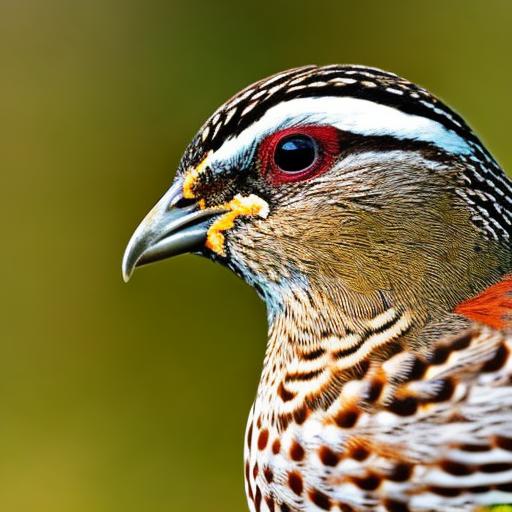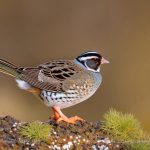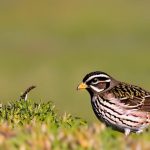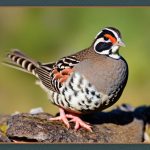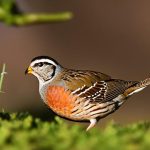Quail are small, ground-dwelling birds that are known for their distinctive calls and quick, darting movements. They are often found in open grasslands, agricultural fields, and brushy areas. Quail are social birds and typically live in coveys, which are small flocks that can consist of up to 20 birds. They are primarily herbivores, feeding on seeds, grains, and insects. Quail are also known for their nesting behavior, as they build their nests on the ground and lay a large number of eggs.
Quail are generally shy and skittish birds, and they prefer to avoid confrontation with humans or other animals. However, they can become a nuisance when they invade gardens, farms, or residential areas in search of food. Understanding the behavior of quail is essential for effectively keeping them away from unwanted areas. By knowing their habits and preferences, it becomes easier to implement strategies to deter them from causing damage or disturbance.
Quail are most active during the early morning and late afternoon, and they tend to forage for food in open areas with low vegetation. They are attracted to areas with abundant food sources, such as bird feeders, spilled grains, or overgrown gardens. By understanding their behavior and preferences, it is possible to identify the areas that are most vulnerable to quail intrusion and take appropriate measures to keep them away.
Key Takeaways
- Quail are ground-dwelling birds that are attracted to areas with abundant food and cover, and they are known to forage in groups.
- Natural ways to keep quail away include removing food sources such as fallen fruits and seeds, and keeping the area clean and free of debris.
- Creating physical barriers such as fences, netting, and covers can effectively keep quail away from specific areas.
- Using repellents such as taste aversions and scent deterrents can be an effective way to keep quail away from gardens and crops.
- Removing attractants such as bird feeders, water sources, and dense vegetation can help discourage quail from frequenting an area.
Natural Ways to Keep Quail Away
There are several natural methods that can be used to keep quail away from unwanted areas. One effective approach is to modify the habitat to make it less attractive to quail. This can be achieved by reducing the availability of food sources and creating barriers that discourage quail from entering the area. For example, removing spilled grains, cleaning up bird feeders, and keeping gardens well-maintained can help reduce the attractiveness of an area to quail.
Another natural way to keep quail away is by introducing natural predators or deterrents. For example, installing bird feeders that attract predatory birds like hawks or owls can help keep quail at bay. Additionally, using scare tactics such as hanging shiny objects or using motion-activated devices can create a sense of danger for quail and discourage them from entering an area.
Planting certain types of vegetation can also help deter quail from entering an area. For example, planting prickly or thorny bushes around the perimeter of a garden can create a physical barrier that quail are unlikely to cross. Similarly, using aromatic plants or herbs with strong scents can help repel quail and make an area less appealing to them.
Creating Physical Barriers to Keep Quail Away
Creating physical barriers is an effective way to keep quail away from specific areas. Fencing is one of the most common methods used to keep quail out of gardens, farms, and other vulnerable areas. A fence with small openings or mesh can prevent quail from entering an area while still allowing other wildlife to pass through. Additionally, installing a fence that extends underground can prevent quail from burrowing under it.
Another physical barrier that can be used to keep quail away is netting. Netting can be used to cover crops, fruit trees, or other vulnerable plants to prevent quail from accessing them. It is important to ensure that the netting is securely fastened and does not pose a risk to other wildlife or pets in the area.
In some cases, creating raised beds or elevated planting areas can also serve as a physical barrier to keep quail away. By raising the level of vulnerable plants off the ground, it becomes more difficult for quail to access them. This approach is particularly effective for protecting small gardens or individual plants from quail damage.
Using Repellents to Keep Quail Away
Repellents can be an effective tool for keeping quail away from specific areas. There are several types of repellents that can be used to deter quail, including chemical, visual, and auditory repellents.
Chemical repellents are often used to create a scent or taste barrier that makes an area unappealing to quail. These repellents can be applied directly to plants or surfaces that quail are likely to target. Common chemical repellents include capsaicin-based sprays, garlic or onion sprays, and commercial bird repellent products.
Visual repellents work by creating a visual deterrent that scares or confuses quail. These repellents often use reflective materials, bright colors, or moving objects to create a sense of danger for quail. Common visual repellents include scare tape, shiny balloons, and predator decoys.
Auditory repellents use sound to deter quail from entering an area. These repellents often emit loud noises or distress calls that create a sense of danger for quail. Common auditory repellents include ultrasonic devices, motion-activated alarms, and recordings of predatory bird calls.
When using repellents to keep quail away, it is important to follow the manufacturer’s instructions and consider any potential risks to other wildlife or pets in the area.
Removing Attractants to Keep Quail Away
Removing attractants is an essential step in keeping quail away from unwanted areas. Quail are attracted to areas with abundant food sources, so removing these attractants can help reduce the likelihood of quail intrusion.
One way to remove attractants is by keeping bird feeders clean and well-maintained. Spilled grains or seeds from bird feeders can attract quail and other wildlife, so regularly cleaning up around bird feeders can help reduce the attractiveness of an area to quail.
Additionally, keeping gardens and agricultural fields well-maintained can help reduce the availability of food sources for quail. This includes regularly harvesting crops, removing fallen fruits or vegetables, and keeping weeds and overgrown vegetation in check.
It is also important to address any sources of standing water in the area, as quail are attracted to water sources for drinking and bathing. By removing standing water or using bird baths with sloped sides that make it difficult for quail to access, it becomes less likely that they will be attracted to an area.
Scaring Quail Away
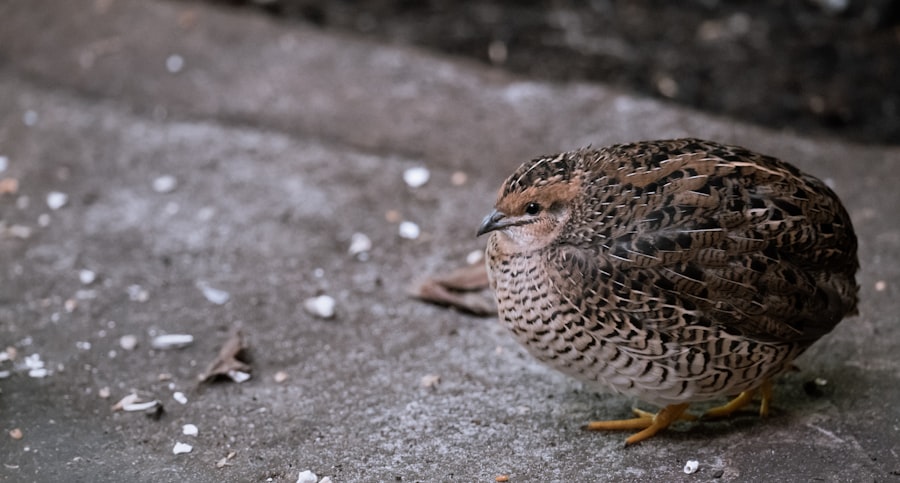
Scaring quail away is another effective method for keeping them out of unwanted areas. There are several scare tactics that can be used to create a sense of danger for quail and discourage them from entering an area.
One common scare tactic is using noise as a deterrent. This can be achieved by using motion-activated alarms, ultrasonic devices, or recordings of predatory bird calls. These noises create a sense of danger for quail and make them less likely to enter an area.
Visual scare tactics can also be effective for scaring quail away. This includes using scare tape, shiny balloons, or predator decoys to create a visual deterrent that makes an area unappealing to quail.
Another effective scare tactic is using motion-activated devices that emit bursts of water or air when triggered by movement. These devices startle quail and create a sense of danger that discourages them from entering an area.
It is important to regularly change the location and type of scare tactics used to prevent quail from becoming accustomed to them.
Seeking Professional Help to Keep Quail Away
In some cases, seeking professional help may be necessary to effectively keep quail away from unwanted areas. Wildlife management professionals have the knowledge and experience to implement effective strategies for deterring quail and preventing damage or disturbance.
Professional wildlife management services can conduct site assessments to identify vulnerable areas and develop customized plans for keeping quail away. They can also provide guidance on implementing long-term solutions that address the underlying factors contributing to quail intrusion.
Additionally, professional wildlife management services have access to specialized tools and techniques for deterring quail, such as trapping and relocation methods that comply with local regulations and ethical standards.
By seeking professional help, property owners can ensure that they are using effective and humane methods for keeping quail away while minimizing the risk of harm to other wildlife or pets in the area.
In conclusion, understanding the behavior of quail is essential for effectively keeping them away from unwanted areas. By implementing natural methods such as modifying the habitat, creating physical barriers, using repellents, removing attractants, scaring quail away, and seeking professional help when necessary, property owners can effectively deter quail and prevent damage or disturbance. With careful planning and implementation of appropriate strategies, it is possible to coexist with quail while protecting vulnerable areas from their intrusion.
Looking to keep quail away from your garden? Check out our related article on what vegetables do quails eat for tips on deterring these birds while also providing them with suitable food sources.
FAQs
What are some natural ways to keep quail away?
Some natural ways to keep quail away include using physical barriers such as fences or netting, planting deterrent plants like marigolds or lavender, and using scare tactics such as reflective objects or noise makers.
Are there any commercial products available to keep quail away?
Yes, there are commercial products available such as quail repellent sprays, electronic deterrent devices, and motion-activated sprinklers that can help keep quail away from specific areas.
Why is it important to keep quail away from certain areas?
Quail can cause damage to gardens, crops, and landscaping by foraging for food and creating dust baths. In some cases, they may also carry diseases that can be transmitted to other animals or humans.
What are some non-lethal methods to keep quail away?
Non-lethal methods to keep quail away include using visual deterrents like scarecrows or shiny objects, applying natural repellents such as garlic or chili pepper spray, and modifying the habitat to make it less attractive to quail.
Are there any legal restrictions on how to keep quail away?
It is important to check local regulations and laws regarding the control of quail, as some areas may have specific guidelines or restrictions on how to manage quail populations. It is always best to use humane and non-lethal methods when dealing with wildlife.
Meet Walter, the feathered-friend fanatic of Florida! Nestled in the sunshine state, Walter struts through life with his feathered companions, clucking his way to happiness. With a coop that’s fancier than a five-star hotel, he’s the Don Juan of the chicken world. When he’s not teaching his hens to do the cha-cha, you’ll find him in a heated debate with his prized rooster, Sir Clucks-a-Lot. Walter’s poultry passion is no yolk; he’s the sunny-side-up guy you never knew you needed in your flock of friends!

